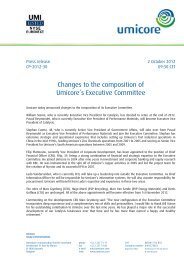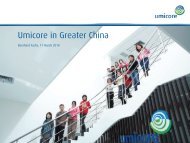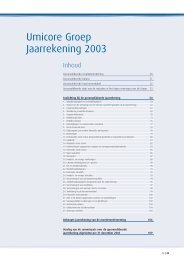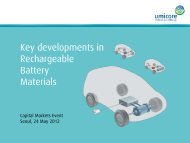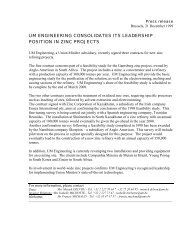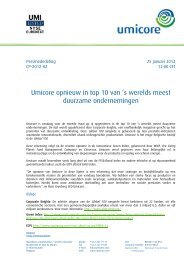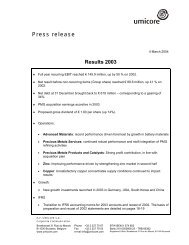Create successful ePaper yourself
Turn your PDF publications into a flip-book with our unique Google optimized e-Paper software.
200<br />
150<br />
100<br />
50<br />
0<br />
Sales Trends<br />
of Germanium Products<br />
(Units of metals sold in 1999 = 100)<br />
1999 2000 2001 2002 <strong>2003</strong><br />
Sales by Business Line<br />
(Electro-Optic Materials)<br />
High-Purity Chemicals 22%<br />
Optics 44%<br />
Substrates 34%<br />
Geographical Breakdown of Sales<br />
(Electro-Optic Materials)<br />
Africa/Middle East 2%<br />
Asia/Australia 14%<br />
Europe 40%<br />
North America 44%<br />
Electro-Optic Materials<br />
Substrates – focus on development projects<br />
Sales volumes of germanium substrates for space solar cells were 30% lower than 2002<br />
as a result of reduced activity levels in the world’s satellite programmes. However, there<br />
was a significant improvement in demand from customers during the second half of the year.<br />
Umicore’s substrates were used on both NASA Mars Explorer Rovers - Spirit and Opportunity - as<br />
part of the solar cells and panels provided by Spectrolab (a Boeing company).<br />
The pace of new product development for germanium substrates continued to increase in <strong>2003</strong><br />
with initial commercial deliveries for use in solid state lighting (LEDs). Development work<br />
in engineered substrates for micro-electronics also shifted into a higher gear with the<br />
development of 300mm (12”) substrates and the announcement of an important partnership<br />
with research institute IMEC and one of the world’s leading silicon-on-insulator producers<br />
(SOITEC). Another important step in this development is the inclusion of germanium in the<br />
IMEC “45 nanometer CMOS” programme in which five of the world’s top ten micro-electronics<br />
companies are participating. Work also continued in Umicore’s Boston facility on the development<br />
of engineered substrates such as thick silicon-on-insulator and germanium-on-insulator.<br />
Slight improvement in optical fibre products<br />
Deliveries of germanium tetrachloride for the fibre optics industry were up by 50% on<br />
the extremely poor levels of 2002. This has been brought about by a limited underlying<br />
improvement in the fibre optics industry where new connections in the so-called “last mile”<br />
to homes and businesses are becoming more frequent. Multi-mode fibres (rich in germanium)<br />
tend to be used for such connections. Umicore began the process of integrating its US production<br />
and sales capabilities into its Quapaw plant – acquired from EaglePicher Technologies during<br />
<strong>2003</strong>. The overall integration of the Quapaw plant (which covers the optics and high purity<br />
chemicals sectors) made good headway with synergies identified for implementation in 2004.<br />
Optics – A wider product offer<br />
Sales volumes for thermal imaging optics materials improved, although increased competition<br />
led to pressure on prices throughout the year. Demand continued to increase for Umicore’s<br />
chalcogenide glass and for automotive night vision systems in particular. In late <strong>2003</strong> Umicore<br />
concluded a four-year agreement with Autoliv to supply optical assemblies – a key component<br />
in car night vision systems – to the automotive industry. A dedicated plant to produce these<br />
optical assemblies for this new application will be built in Quapaw. Full production is expected<br />
to be reached in mid-2005. This project is a world first in the large scale production of infra-red<br />
optics for a commercial application and will support new opportunities for this material in<br />
different high-volume infra-red markets.<br />
On the development front Umicore developed and qualified several new products in a<br />
number of materials for laser optics equipment manufacturers. The increased optics range<br />
was further complemented by the introduction of silicon and copper mirrors.



